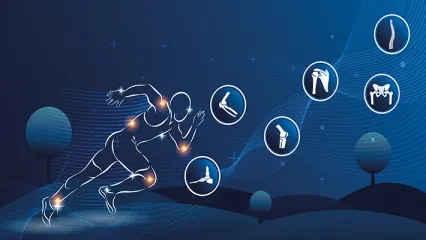Alo Yeditepe
Alo Yeditepe
Wrist Pain Causes and Treatment
What Causes Wrist Pain?
The wrist, which has a complex structure, is more affected by injuries due to this structure. Orthopedics and Traumatology specialist Op. Dr. Ömer YONGA stated that there are many problems that can manifest themselves with pain in the wrist, apart from trauma, and pointed out that pain that may occur in the wrist should be taken seriously. He said that neglecting the pain or people's unconscious wrong practices make the situation worse.
Pain in the wrist, which plays a very important role in the ability of the hand to perform its movements, is one of the common joint problems. People who have to work in front of a computer for a long time, do sports or do a job that requires repetitive wrist movements are in the potential risk group for wrist pain. However, wrist pain may occur after some diseases, wrong exercises and trauma. At this point ,Yeditepe University Koşuyolu Hospital Orthopedics and Traumatology Specialist Op. Dr. Ömer YONGA pointed out the importance of consulting a doctor in time. Orthopedics and Traumatology Specialist underlines that there may be more serious problems that do not appear on the basis of pain, and he said that neglecting pain, trying to self-diagnose and treat, continuing painful movements, overusing painkillers, forcing movements despite pain and also going to the doctor late are among the most common mistakes made by patients.
Does the Complex Anatomical Structure of the Wrist Increase the Possibility of Injury?
“The anatomical structure of the wrist consists of a series of bones, ligaments, tendons and nerves. These structures ensure the durability of the wrist and allow various movements. Orthopedics and Traumatology specialist said that ''However, this complexity can also increase the potential for susceptibility to injuries, and He continued his words as follow “Wrist injuries can occur due to various factors such as falls, impacts, repetitive movements, fractures or sprains. Taking protective measures and paying attention to proper ergonomics can reduce wrist injuries. "It is important to use protective equipment and perform repetitive movements carefully, especially during risky activities,"
Regardless of traumas, wrist pain can be a symptom of which diseases?
Stating that some diseases can cause pain in the wrist, regardless of trauma, Orthopedics and Traumatology Specialist explained the following on the subject: "Inflammation of the tendons in the wrist (tendinitis-tenosynovitis), compression of the median nerve in the wrist (carpal tunnel syndrome), inflammation of the tendons on the thumb side (de quervain tenosynovitis). ), stretching or tearing of the ligaments in the wrist, formation of fluid-filled sacs in the tendon or joint capsule of the wrist (ganglion cysts), fracture or sprain in the wrist bones, and accumulation of uric acid in the joints are the most common wrist disorders.
The Character of Pain is an Important Clue
Saying that the character of wrist pain provides an important clue in determining the underlying problem, Orthopedics and Traumatology Specialist explained the following about these signs: “While sharp-sudden onset pains may occur with fracture, sprain, ligament injury and also acute trauma, smooth and slow-onset pains can be occured and theese pain caused by chronic overuse tendinitis.” The fact that the pain wakes the patient up at night, that the patient feels the need to shake his/her hands, and that he/she frequently starts to drop objects such as glasses and plates from his/her hands due to loss of strength, makes us think of carpal tunnel syndrome. If there is swelling along with pain, ganglion or other soft tissue masses may be seen. These characteristics are important for a healthcare professional in the clinical evaluation and diagnosis process. In addition, details such as the onset of pain, its severity, frequency, and sensitivity to other factors should also be evaluated. It should not be forgotten that everyone's perception of pain is different and the same type of pain may occur due to different reasons.”
What Should Those with Thin Wrists Pay Attention to?
Orthopedics and Traumatology Specialist says that whether a person's wrist is thin or thick may pose a risk for problems in the wrist. A thin wrist generally has less soft tissue, which may cause bones and other structures to be weaker against external factors. Tendons and ligaments may be more prominent in thin wrists, causing these structures to become more sensitive to external factors. When individuals with thin wrists are exposed to the same forces, this force may be felt more on the individual's wrist, thus increasing the risk of injury. It should not be forgotten that wrist structure is not the sole determinant of wrist problems. A number of factors may also be influential, such as activity levels, age, general health, exercise habits and work conditions.
Treatment of Wrist Pain
Pointing out that wrist pain can be serious and cause different problems if neglected, Orthopedics and Traumatology Specialist explained the following on the subject: “For example, long-term compression of the nerve in carpal tunnel syndrome can cause permanent damage to the nerve. Again, if tendon inflammation is not treated, it can lead to long-term loss of function and tendon damage. Untreated or missed fractures and dislocations can cause pain, swelling, limitation of movement in the joint and joint damage in the future, and cysts, which we call ganglion, can put pressure on the nerves and tendons around them as they grow, which causes pain. Therefore, wrist pain should be taken seriously and the underlying cause should be revealed.” Yeditepe University Hospitals Orthopedics and Traumatology Specialist expressed his warnings as follows: “It is important to rest the painful wrist, avoid overuse and take appropriate protective measures. Paying attention to ergonomics in the work or home environment can also protect the wrist from excessive strain. In addition, in case of pain, an orthopedic specialist should be consulted without wasting time.”
About
Faculty and Year of Graduation:
Erciyes University Medical Faculty, 2011
”
See Also
- What are Hip Joint Diseases? Causes and Treatment
- What is Hallux Rigidus (Stiff Big Toe/Toe Arthritis)? Symptoms and Treatment
- What is Hallux Valgus (Bunion)? How is it Treated?
- What is a Bone Tumor? Bone Tumor Symptoms
- What is Crooked Leg? Can Crooked Legs Be Treated?
- Ergonomics in Automobiles Prevents Accidents
- Don't Underestimate Bone Pain That Doesn't Make You Sleep and Doesn't Relieve With Medication
Alo Yeditepe




